In situations where the teeth overlap to such a degree that the edges of the lower front teeth actually bite into the hard palate, orthodontists recommend the bite plate appliance.This is a removable device that looks like a conventional retainer in most cases. A bite plate appliance is worn full-time (except when eating and brushing) for six months to a year.
Correcting a deep bite as early as possible will favorably affect long-term stability and eliminate unnecessary pain, discomfort, ulcers, etc. When this correction is done while a person is still growing, the change becomes more permanent.
One of the first things to relapse in a finished orthodontic case is the overbite. Thus, correcting a severe overbite is one of the first important corrections that needs to be made while growth is still occurring.
Bite turbos are small acrylic pads typically bonded to the upper front teeth. They are used to correct excessive deepbites and overbites, as well as lessen the amount of time spent in braces.
After bite turbos are placed, you will notice that the back teeth do not meet properly when chewing. This is temporary. Eating soft foods like mashed potatoes or macaroni and cheese will help you adjust to your new bite.
Your tongue may be irritated the first three to five days. You may also have difficulty speaking, eating and swallowing. These should improve within a week or two.
Be sure to brush between the turbos and the gums. Although it is not likely that a bite turbo will come off, if it does, it's no problem. If you happen to lose them, give us a call, so we can replace them if needed.
The bite turbos will be removed when the desired correction is achieved.
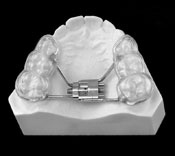
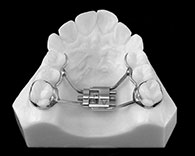 Attached to the upper molars through bonding or by cemented bands,
the Bonded Maxillary Expander is an orthodontic device used to
create a wider space in the upper jaw. It is typically used when
the upper jaw is too narrow for the lower jaw or when the upper
teeth are crowded or blocked out of the dental arch.
Attached to the upper molars through bonding or by cemented bands,
the Bonded Maxillary Expander is an orthodontic device used to
create a wider space in the upper jaw. It is typically used when
the upper jaw is too narrow for the lower jaw or when the upper
teeth are crowded or blocked out of the dental arch.
When patients are still growing, their connective tissue between the left and right halves of their upper jaw is very responsive to expansion. By simply activating the expander through turning a screw in the center using a special key we provide, gradual outward pressure is placed on the left and right halves of the upper jaw. This pressure causes an increased amount of bone to grow between the right and left halves of the jaw, ultimately resulting in an increased width.
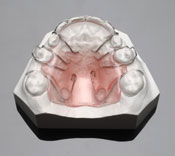
The Cetlin appliance works in conjunction with headgear to create space when there is not enough room for the upper permanent teeth to erupt. This removable appliance helps to push the upper molars back.
The Cetlin must be worn 24 hours a day in order for it to be effective. You can remove the appliance to eat or drink but must place it back in your mouth afterward. Proper wear is essential.
Each day, always examine the appliance to make sure the back wires are in front of the molar bands. The wires help the headgear to push the molars back.
Your teeth may be sore for the first few days of wear. Initially, speaking may be difficult, but the more you talk with the appliance in, the quicker speaking will become normal again. Increased saliva the first few days is also normal.
Be sure to brush your appliance each day. You can also soak it in denture cleaner a few times a week. Immediately after brushing, put the appliance back in your mouth.
Heat can warp the Cetlin appliance. Do not attempt to clean the appliance by placing it in hot water or in the microwave. Do not leave it near an oven or in the car.
When you are not wearing your appliance, be sure to keep it in your case.
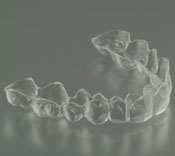
Clear removable appliances can be used to effectively straighten your teeth without metal wires or brackets. We use 3D computer imaging technology to customize them for your bite. Each set of removable appliances is worn for two weeks. You should only remove them when you’re going to eat, drink, brush or floss. As you replace each set of clear aligners with the next set in the series, you'll notice your teeth gradually move, week by week, until the desired correction is achieved. You'll visit the office every six weeks to ensure your treatment is progressing as planned.
If you're using Invisalign aligners to achieve that perfect smile, then these tiny but mighty tools are about to become your new best friend. But what exactly are Invisalign chewies, and why should you be using them? Read on to learn more.
The Importance of Using Chewies with Invisalign
When it comes to straightening your teeth, Invisalign has become a popular choice for many people. These clear aligners offer a discreet and convenient alternative to traditional braces. However, did you know that using chewies along with your Invisalign treatment can make a big difference in the effectiveness of the aligners?
Chewies are small cylindrical cushions made of soft material, usually made from Styrene Copolymer. They are designed to help seat your aligners properly and ensure they fit snugly against your teeth. But why is this important?
Well, proper seating of the aligners is crucial because it helps apply consistent pressure on your teeth throughout the day. This pressure is what gradually moves them into their desired positions. If the aligners don't fit well or have any gaps between them and your teeth, they may not be able to exert enough force to achieve optimal results.
By using chewies regularly during your treatment, you can enhance the fit of your aligners and improve their overall performance. Simply biting down on them for a few minutes each day helps to close any small gaps and ensures that the trays are fully seated against your teeth.
How Do Invisalign Chewies Work?
When you first start wearing your Invisalign trays, they may feel snug and tight against your teeth. This is because the aligners are designed to gradually shift your teeth into their desired positions. However, sometimes, there can be small gaps between the aligner and certain areas of your teeth.
This is where the Invisalign chewies come in handy. By biting down on them for a few minutes each day, you apply gentle pressure to help seat the aligners more securely against your teeth.
The chewies act as an aid in making sure that all parts of your aligners are fitting properly and snugly against your teeth. They also help to distribute forces evenly across the entire surface area of each tooth.
Using Invisalign chewies regularly can optimize the effectiveness of your treatment by ensuring that every tooth receives consistent and balanced pressure from the aligners. So don't underestimate these simple yet powerful tools — they play a crucial role in achieving those beautiful straight smiles!
Benefits of Using Invisalign Chewies
Using Invisalign chewies can provide numerous benefits throughout your orthodontic treatment journey. Here are some advantages to incorporating these small yet mighty tools into your routine:
- Enhanced aligner fit: One of the key benefits of using Invisalign chewies is that they help improve the fit and effectiveness of your aligners. By biting down on the chewie, you apply gentle pressure to ensure that your aligners are snugly fitted against your teeth, promoting more precise tooth movement.
- Shorter treatment time: Regular use of chewies can potentially speed up the overall duration of your Invisalign treatment. The consistent application of force while chewing helps stimulate blood flow and encourages proper alignment, thus aiding in quicker progress toward achieving straighter teeth.
- Reduced discomfort: Wearing aligners might initially cause slight discomfort or pressure as they shift your teeth into their desired positions. However, chewing on a soft but firm material like an Invisalign chewie can alleviate this discomfort by distributing forces evenly across your dental arches.
- Improved Oral Hygiene: Another added advantage is that using chewies promotes better oral hygiene during treatment with clear aligners. These handy tools help seat the trays correctly over each tooth, preventing gaps where food particles could get trapped and ensuring optimal oral cleanliness.
Conclusion
The benefits of incorporating Invisalign chewies into your orthodontic journey are numerous. Remember to consult with our orthodontist about their recommendations for incorporating Invisalign chewies into your treatment plan. They will guide you on how often to use them based on their assessment of your specific needs.
Embrace this valuable tool and let it assist you on your journey towards dental perfection!
Accurate placement of brackets is a significant factor in successful orthodontic treatment. Using direct bonding, each bracket is cemented to teeth one at a time. During the procedure, our orthodontist uses tweezers or other hand instruments to accurately position a bracket on a tooth. Once the bracket is in its precise location, it is firmly cemented.
Elastics are a vital part of treatment and are also contingent upon patient compliance. They add extra pressure to the braces to help move the teeth. Generally worn at all times (excluding while eating and brushing your teeth), elastics should be changed at least three times a day. They come in various sizes as they are each used for a specific purpose. We will provide you with the appropriate size.
It is important to wear them consistently or treatment setbacks may occur. If you miss only one day, it could cause your teeth to shift back to their original position!
Class II
Class III
Triangle/Openbite
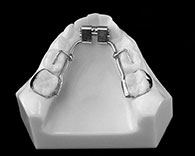
A Fixed Mandibular Expander is used as an alternative to the removable Schwarz appliance. It can be used on the upper or lower arches to expand the arch and create the needed additional space for the permanent teeth. Featuring a miniature version of an RPE screw, a Fixed Mandibular Expander is a good option when patient compliance may be an issue.
The canine teeth are the first teeth that meet when the jaws close. They help to guide the remaining teeth into the proper bite. After wisdom teeth, the upper canines are the second most common teeth to become impacted. Impacted canine teeth must be surgically exposed to help them erupt.
Surgical options can vary based on the patient's case, but treatment is typically a team effort for an orthodontist and an oral surgeon.
Typically, before the surgery, the orthodontist places braces on the teeth. A space is opened for the impacted canine to be moved into its proper place. The oral surgeon will then perform surgery to remove some of the gum tissue and bone covering the tooth, to expose the tooth. A bracket and gold chain are then bonded to the tooth, so the orthodontist can initiate treatment for repositioning it into its proper place.
With indirect bonding, we can ensure your brackets are positioned at the perfect place with computer precision. First, we will create a model of your teeth, and then study each tooth to determine the ideal position and angle for the bracket to be placed. After all locations have been decided, we will attach the brackets to the model, and cover them with a soft, flexible tray material, creating a cast of your teeth with the braces attached. We will then apply the bonding solution to each of the brackets. After that, it's simply a matter of fitting the tray onto to your teeth, applying a little pressure, and bingo! Perfectly placed brackets every time!
Indirect bonding benefits our patients immensely by minimizing discomfort and making orthodontic treatment as efficient as possible.
Interproximal recontouring refers to a procedure in which we will reshape your teeth by sculpting the sides of the teeth. This can correct cracked, chipped, crooked, or misaligned teeth. Instead of braces, crowns or veneers, you can choose to have interproximal recontouring to change the shape and look of your teeth to enhance your smile!
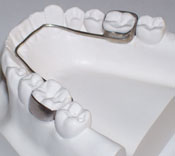 A Lower Lingual Arch acts as a space maintainer to keep the
molars from drifting forward and prevent them from blocking the
space where permanent teeth will eventually erupt. This appliance
is commonly used in cases of premature loss of baby teeth or when
the lower teeth of a growing child are slightly crowded and no
permanent teeth are extracted to correct the problem.
A Lower Lingual Arch acts as a space maintainer to keep the
molars from drifting forward and prevent them from blocking the
space where permanent teeth will eventually erupt. This appliance
is commonly used in cases of premature loss of baby teeth or when
the lower teeth of a growing child are slightly crowded and no
permanent teeth are extracted to correct the problem.
You should expect soreness the first day or two, and it may hurt to chew. We recommend a soft diet initially. You may take Advil or Tylenol to relieve the pain. Avoid sticky or hard foods, and please monitor how many foods you eat that are high in sugar.
Brushing and flossing daily are very important. Be sure to clean around the bands that are connected to the molars and the wire on the tongue side. This will prevent the formation of cavities or infection of the gums.
The duration of wear varies. We will monitor the eruption of new teeth and make adjustments. Generally, the Lower Lingual Arch is removed following the eruption of all the permanent teeth.
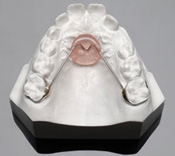 The Nance Appliance is used to prevent upper molars from
rotating or moving forward after you've worn headgear, a Wilson's
arch, or any other appliance to move your molars back. Some
patients wear the Nance Appliance while they are awaiting their
bicuspids to grow into place.
The Nance Appliance is used to prevent upper molars from
rotating or moving forward after you've worn headgear, a Wilson's
arch, or any other appliance to move your molars back. Some
patients wear the Nance Appliance while they are awaiting their
bicuspids to grow into place.
The appliance is made of two bands that are cemented onto the first molars and a wire that spans the roof of the mouth from one molar to the other. An acrylic pad or "button" covers the wire that touches the roof of your mouth directly behind your front teeth.
Patients should always brush around the bands daily. Do not eat sticky, chewy candy as it can loosen your appliance.
A power chain is a continuous band of elastics attached to your brackets. Orthodontists use these to close a gap between the teeth. By exerting extra force, a power chain helps move the teeth faster. Because they hold your teeth closely together, a power chain can also be used to ensure that your teeth do not move apart.
Like regular elastics, power chains come in various colors and are changed at each orthodontic visit. When the power chain is first placed, there may be a little discomfort until you become accustomed to the fit and feel.
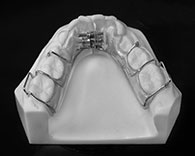 The Schwartz Appliance is a removable expansion appliance
primarily used on the lower arch to expand the arch and create
needed additional space for the permanent teeth. Treatment time of
using the Schwartz Appliance is approximately nine months but will
vary based on individual needs of the patient. If both the upper
and lower arches require expansion, we may use the Schwartz along
with a Rapid Palatal Expander to coordinate the expansion of both
arches.
The Schwartz Appliance is a removable expansion appliance
primarily used on the lower arch to expand the arch and create
needed additional space for the permanent teeth. Treatment time of
using the Schwartz Appliance is approximately nine months but will
vary based on individual needs of the patient. If both the upper
and lower arches require expansion, we may use the Schwartz along
with a Rapid Palatal Expander to coordinate the expansion of both
arches.
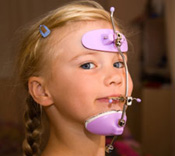 Headgear is often used to correct an excessive overbite. This is
done by placing pressure against the upper teeth and jaw, which
would hold the teeth in position or help move them into better
positions.
Headgear is often used to correct an excessive overbite. This is
done by placing pressure against the upper teeth and jaw, which
would hold the teeth in position or help move them into better
positions.
The key to success with your headgear appliance is consistency. The severity of the problem determines how many months headgear needs to be worn. Nevertheless, headgear must be worn a certain number of hours per day, and if not, it must be made up the following day. That said, headgear should never be worn while playing sports and should also be removed while eating or brushing your teeth.
Separators are small elastics that fit snugly between certain teeth to move them slightly so bands can be placed around them later. Separators can fall out on their own if enough space has already been created. To determine if it needs to be replaced, slip some dental floss between the teeth; if it gets stuck, that means the separator hasn't created enough room and needs to be replaced prior to your banding appointment.
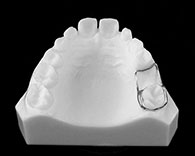 A Space maintainer keeps the vacated space open until the
permanent tooth is ready to come in. Not every tooth that is lost
too early requires a space maintainer. If one of the four upper
front teeth is lost early, the space will stay open on its own
until the permanent tooth comes in.
A Space maintainer keeps the vacated space open until the
permanent tooth is ready to come in. Not every tooth that is lost
too early requires a space maintainer. If one of the four upper
front teeth is lost early, the space will stay open on its own
until the permanent tooth comes in.
A space maintainer is made of stainless steel and/or plastic. Some space maintainers are removable, which fixed space maintainers are cemented into the patient's mouth.
There are two general types of space maintainers:
- Removable Space Maintainers
- Fixed Space Maintainers
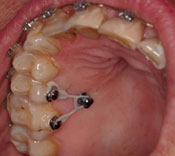 One of the many important advances in orthodontics has been the
development of temporary anchorage devices, or TADs. Made of a
bio-compatible titanium alloy, TADs are mini screw anchors which
are inserted into specific places in the mouth to be used as a
fixed point from which teeth can move.
One of the many important advances in orthodontics has been the
development of temporary anchorage devices, or TADs. Made of a
bio-compatible titanium alloy, TADs are mini screw anchors which
are inserted into specific places in the mouth to be used as a
fixed point from which teeth can move.
Before TADs, orthodontists who wanted to move some teeth while keeping others still, or to achieve orthodontic movement in a mouth with missing teeth, had to rely on headgear for their fixed point. But TADs now provide an option for that fixed point that is smaller, more discreet, more efficient and requires significantly less work for the patient.
Temporary anchorage devices may not be recommended for some patients. In fact, anchorage devices may not be needed at all in many cases. Contact us if you'd like to know more about TADs and how they can potentially prevent you from needing orthodontic headgear.
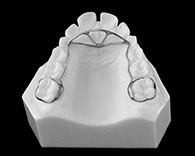
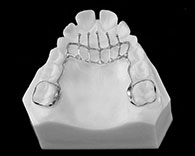
Sucking is a natural reflex that relaxes and comforts babies and toddlers. Children usually cease thumb sucking when the permanent front teeth are ready to erupt. Typically, children stop between the ages of two and four years. But thumb sucking that persists beyond the eruption of primary teeth can cause improper growth of the mouth and misalignment of the teeth. If you notice prolonged and/or vigorous thumb sucking behavior in your child, talk to our dentist.
One solution to thumb sucking is an appliance called a "fixed palatal crib." This appliance is put on the child's upper teeth by an orthodontist. It's placed behind the upper teeth on the roof of the mouth. The crib consists of semicircular stainless steel wires that are fastened to molars using steel bands. The stainless steel wires fit behind the child's upper front teeth, and they are barely visible. The crib usually stops the habit of thumb sucking within the first day of use.
A tongue crib is used to help break bad habits such as tongue thrusting and thumb sucking by retraining the tongue. The crib is a metal appliance that is attached to your upper teeth by fixed bands. It has a block, or a gate, that prevents your tongue from moving forward.
Tongue thrusting can cause an overbite by pushing your front teeth forward. If you are a tongue thruster, the crib retrains your tongue to not touch the front teeth.
Thumb sucking can also cause an open bite. If your child sucks his/her thumb, the crib blocks the thumb from being inserted.
To have enough time for the tongue to be retrained and the bad habit terminated, the tongue crib is usually left in place for six months to a year.
Locations
- MON - THU9:00 am - 5:00 pm
- FRIClosed
- SAT8:45 am - 1:00 pm
- SUNClosed
- MON - THU9:00 am - 5:00 pm
- FRIClosed
- SAT8:45 am - 1:00 pm
- SUNClosed
